TRANSVAAL MINERS STRIKE 1913,
INDUSTRIAL VIOLENCE IN AND AROUND JOHANNESBURG
Jeff Woolgar‘THE GREAT STRIKE ON THE RAND.’
The six picture postcards illustrated here are each headed, ‘THE GREAT STRIKE ON THE RAND’ and captioned in black at the foot. The backs are left blank, and I have not seen any that entered the postal system. None of these cards are numbered. Some collectors call cards printed on one side only ‘Art Cards’ or ‘Proofs’. Nevertheless, I always term them as ‘picture postcard’, as it is sometimes possible to find the same picture postcards, with or without the backs printed or blank cards which have been postally used. Here I have given each card a number; in order to establish a catalogue. These are printed letterpress and most of the cards examined have set-off from the caption. The board is not square and the cards are difference sizes up to 3mm at most. It is therefore not surprising to find the printing is not always straight. Perhaps these were produced quickly by a local printer. Moreover, it is possible that they were printed one at a time on a platen machine, by an apprentice.
Five of these have been catalogued before, and published by Archie Atkinson during June 1995. However, I have changed the sequence here to what I consider to be the likely chronological order of events.
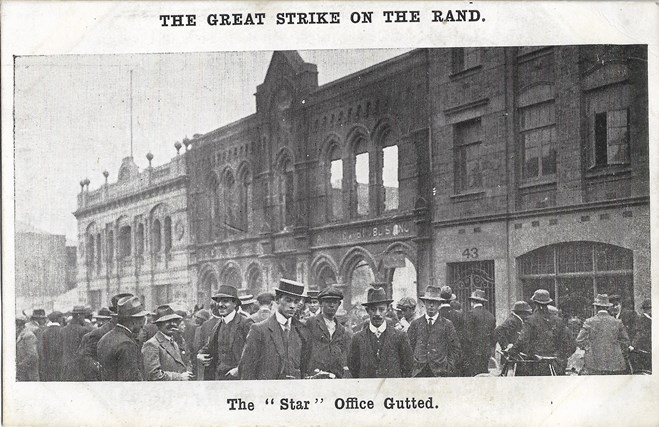
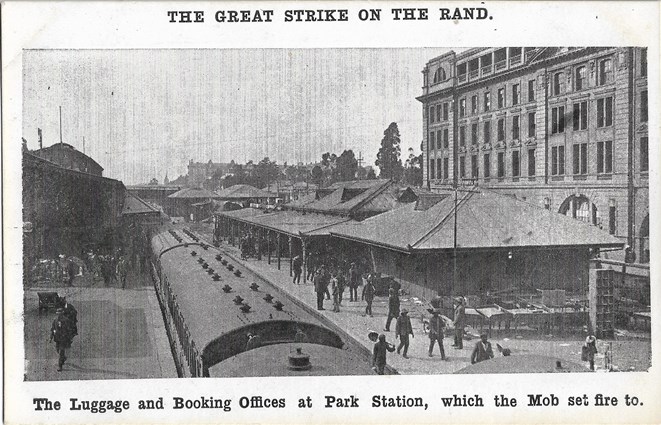
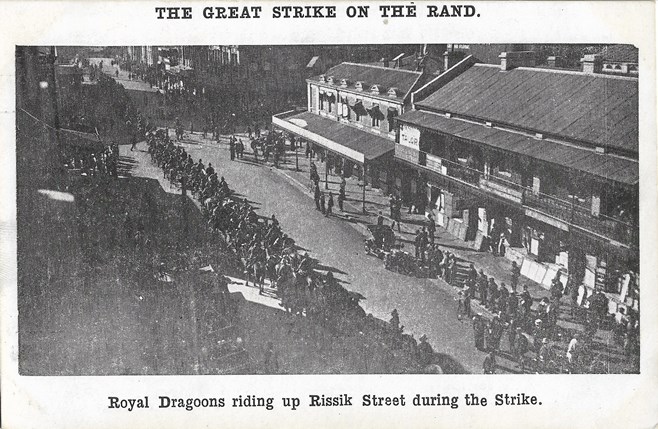
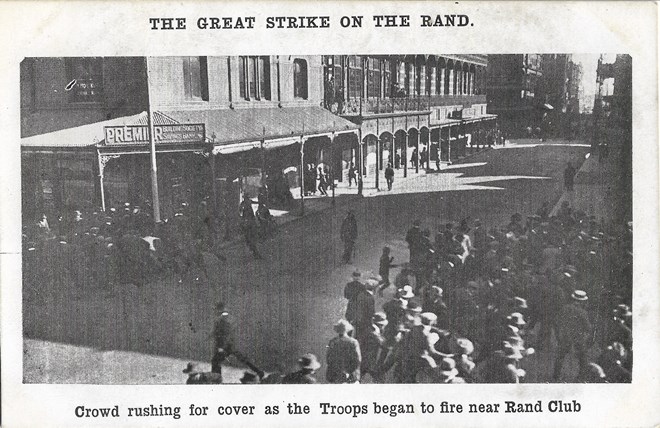
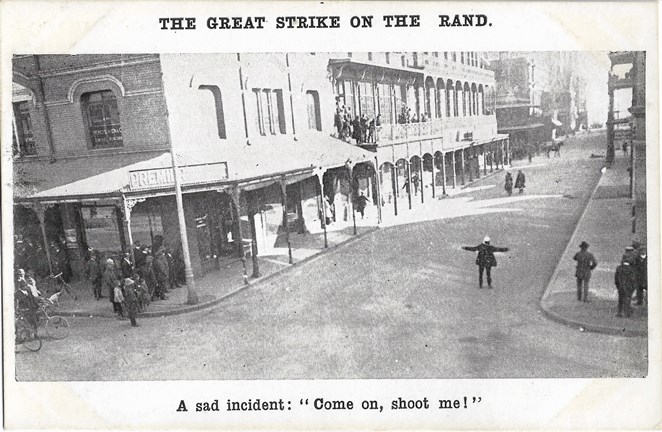
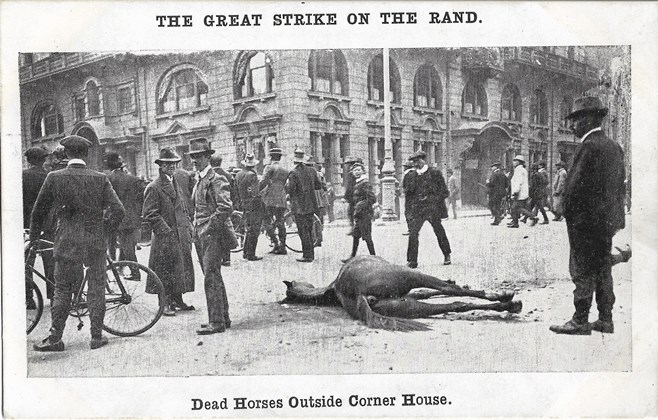
Postcards printed in Black
No. 1. 'The "Star" Office Gutted.'
No. 2. 'The Luggage and booking Offices at Park Station, which the Mob set fire to.
No. 3. 'Royal Dragoons riding up Rissik Street during the Strike.'
No. 4. 'Crowd rushing for cover as the Troops began to fire near Rand Club.'
No. 5. 'A sad incident: "Come on, shoot me!" ' ***
No. 6. 'Dead Horses Outside Corner House.'
Norwich, page 144, illustrates a picture postcard showing a photograph of Monty Dunmore selling copies of the ‘Strike Herald’. Printed in black only, the card is headed ‘THE JULY 5th. MASSACRE.’ and captioned ‘MONTY DUNMORE. / The little 13 year old who was shot through the back while selling “Strike Heralds” to the crowd at the Rand Club.’ This postcard may have been produced with the other postcards illustrated here. However, Norwich did not record what was on the back of the card.
According to the 'Newsletter, S.A.P.R.G.' editor, Archie Atkinson records, in the December 2002 edition, page 11, that many of the photographs of ‘The Great Strike on the Rand – 1913’, were taken by Erich Füsslein’s Father. He was referring to those which are illustrated here and have no imprint. He also records that some cards have been seen with a dealer’s rubber-stamp ‘Post Card’ applied to the back with a dividing line. It was also recorded that the police confiscated the photographs on the grounds that they appeared to support the strikers. However, Füsslein had already made copies. These photographs included a red-headed miner from Nigel, J.L. Labuschagne, defying the troops outside the Rand Club to shoot him dead, which they did.
However, Oscar Norwich said that this was not Loveday Street where the Club was, but at the corner of Fox and Rissik streets.* Later it was stated that the man short was not Mr. J.L. Labuschagne. The miner and author L.S. Nesbitt, who was there, considered that he man was an Afrikaner - see below for his recollections of this unfortunate event. Below is a list of those killed and those who were injured.
Archie Atkinson, writing in June 1995, was not sure if Füsslein had taken the photographs or how many printings there were, as one card, numbered here above as No.5 is also known with the heading ‘AN INCIDENT OF THE STRIKE’ and captioned ‘ “Come on, Shoot me!” This card is also blank on the back. Then there are the three brown cards from the Joan Matthews collection illustrated below.
Lewis Mariano Nesbitt records the events that day.
Nesbitt had arrived in Johannesburg during the 1913 strike; ‘in order to see the cavalry chargers and the encounters between the demonstrators and the troops …’. Towards evening he was in, ‘Commissioner Street, when rifle-fire began again, for the bands of demonstrators had reformed. The demonstrators ran for refuge round corners and into doorways. [His friend] Romano pushed his way into a crowd in the entrance of a shop, and I concealed myself at first behind the posts of a veranda. But I felt that my cover was insufficient, and, looking about me I caught sight of a shop door close by in which there was only a single [black African]. A moment afterwards shots rang out again, and the fanatical strikers who had remained in the middle of the street fell in twos and threes at each burst of firing, for the troops were using machine-guns, and the bursts of fire came in quick succession. The unfortunate strikers fell where they stood, just as several skittles fall each time a ball is thrown amongst them. All this was too close to me … so I moved and managed to reach the corner of the street, where a crowd of strikes were watching the scene unobserved. Once more the shooting started; and then from the mist of the crowd amongst which I was standing, a Boer miner forced his way out into the open without speaking or uttering a sound. His face was strangely set, and his eyes were rolling in his head. He flung clear of the group, and, walking deliberately into the middle of the deserted street, he halted and tore open his shirt, exposing his bare chest; and so stood. Then at last spoke, but what he said I could not understand; it was more like savage howling, at once ferocious and mournful, than speech.
'… Dead men lay on the ground all about the Boer, and amongst them were a number of wounded, convulsed in their agony and crying horribly. Tar-tat-tat-tat went the machine-gun, and the Boer fell and was silent. The crowd … waving their handkerchiefs, indicating that they desired to be allowed to go to the assistance of their fallen fellows … .' Later Nesbit ventured out into the city looking for his friend Romano. When he came to the place in the doorway in which he had taken shelter with the black African, ‘and there I found the unfortunate African stretched on the ground, dead.** 'The glass door and windows of the shop had been smashed by a hail of bullets, and it was clear that I should have stood little chance of escaping alive had I remained there.'
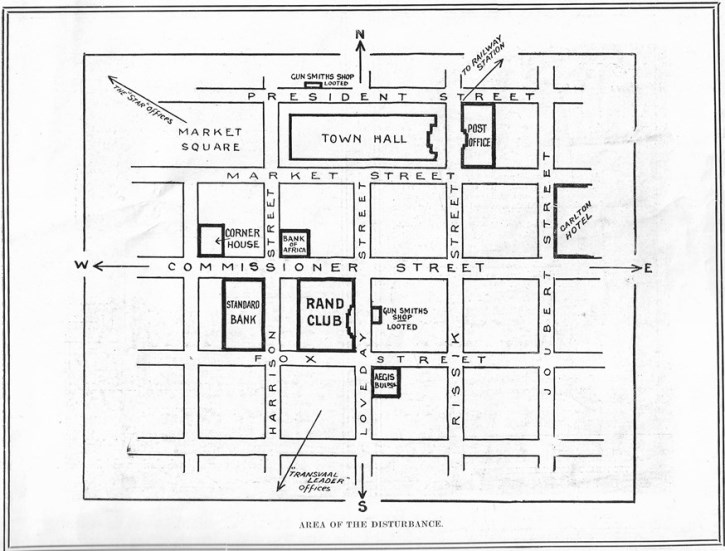
The four picture postcards illustrated below are printed in brown and each is headed, ‘THE GREAT STRIKE ON THE RAND.’ and captioned in brown at the foot of the postcard. The reverse side of the card, which here is numbered 'brown 7', is left blank. The other two cards, 'brown 2.' and 'brown 6.’ have printed divided backs in brown, with 'POST CARD' at the top.
In June 1995 Archie Atkinson catalogued a set of postcards which he said were printed in ‘Sepia’. He catalogued eight postcards given them numbers, 1 to 8. These are not in chronological order, i.e. the card of the troops leaving Johannesburg he numbered, ‘2’. I am not sure if these postcards printed in brown are his sepia cards. Therefore, I feel I need to keep to his listing as I can only illustrate three of the postcards which were on his list of sepia cards. Atkinson also noted that some of these postcards have on the reverse side printed divided backs and made a list of those seen. However, I feel that each of these brown cards will be found, both with, and without the backs printed. I have illustrated one below. I have not seen any that entered the postal system. I consider that the brown cards can be designated as scarce, as these are the only three I have seen.
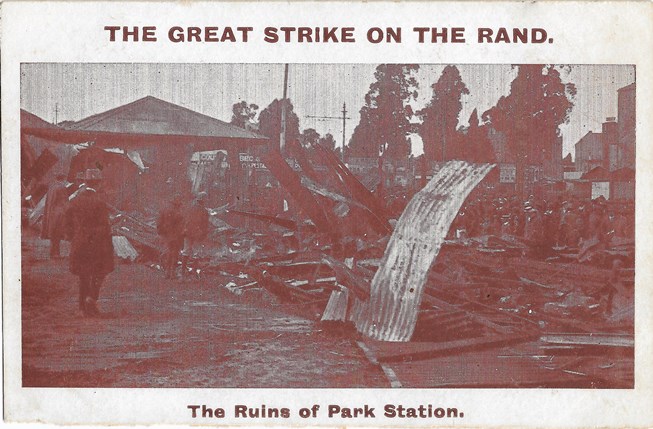
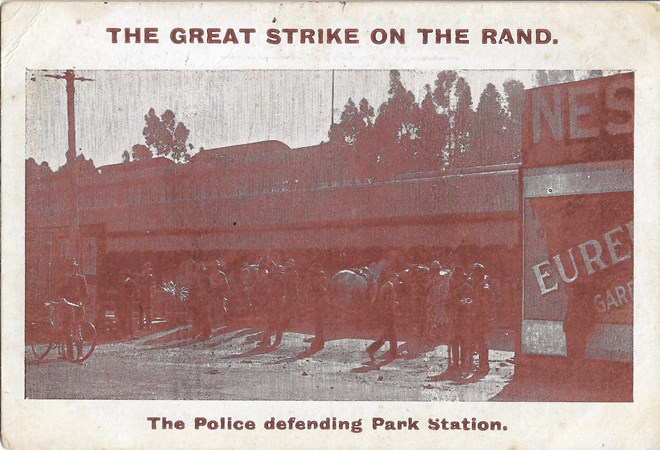
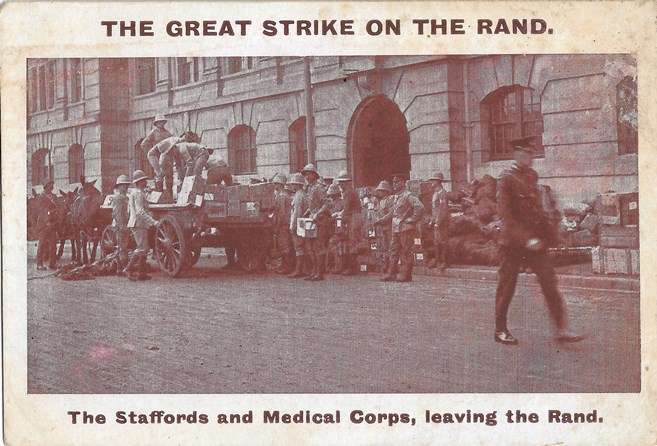
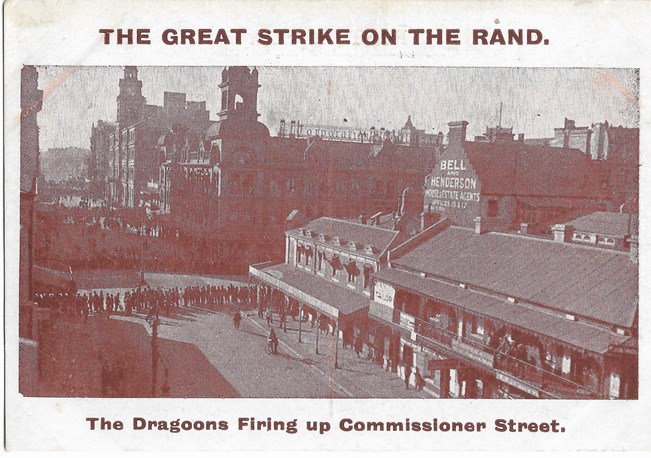
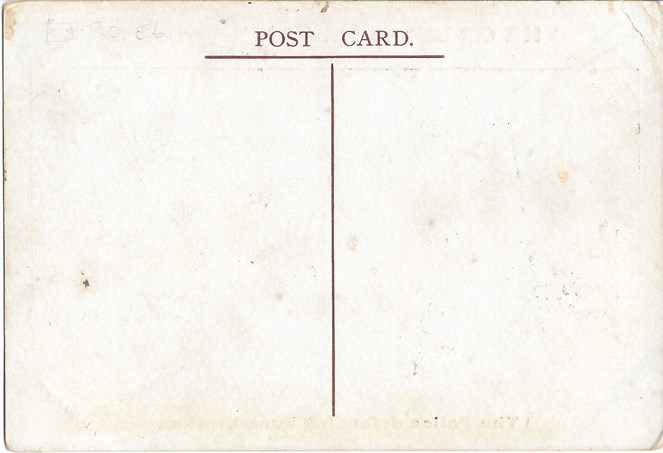
Postcards printed in Brown
No. brown 7. 'The Ruins of Park Station.'
No. brown 6. 'The Police defending Park Station.'
No. brown 2. 'The Staffards and Medical Corps, leaving the Rand.'
No. brown 5. 'The Dragoons Firing up Commissioner Street.'
Füsslein sold his business to W.M. Berlin (who retained his Johannesburg Post Office Box, 2262) and left the industry to farm in Natal. Berlin later published at least three picture postcards featuring photographs from the General Strike of 1914. (A page of these W.M. Berlin follows below.)
CONCLUSION
It would seem that the reason there was no imprint on the backs of these postcards, was that the police may have confiscated the printing plates, if they knew the printers address. There were many jobbing printers in Johannesburg, and payment for printing, and the cost of the printing plates would have been in cash. Therefore, three or more printings could have been made, with perhaps reprints made available in 1914 as there were similar postcards printed for the bloody 1914 strike, called the 'General Strike'.
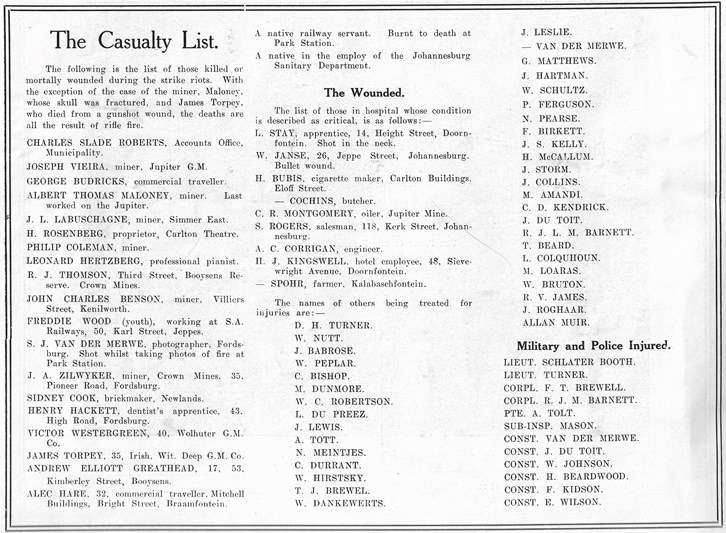 The 1913 casualty list, those killed and those who were injured.
The 1913 casualty list, those killed and those who were injured.
* I have not found a picture that matches the view in the postcard above, even taking account of the shadows; it could have been Loveday Street or Fox Street.
** In the Transvaal and later in the Union of South Africa, the names of women, youths, and Africans are not always recorded in government papers, newspapers, etc. The African killed in Fox Street was possibly: ‘A native in the employ of the Johannesburg Sanitary Department’. Another African was reported as ‘A native railway servant. Burnt to death at Park Station.’
*** Postcard No.5. It is possible that one of the men running for safety is L.M. Nesbitt. He states that: ‘... Dead men lay on the ground all about the Boer, and amongst them were a number of wounded ...’. However there are no dead and wounded in the picture of this postcard. It is therefore likely that those men on the ground were in the original photograph, being removed from the printing plate which produced this postcard.
Acknowledgments
Nine of the ten picture postcards illustrated above were made available to me some years ago.They formed part of the outstanding collection of Transvaal related picture postcards by the late Joan Matthews, who was keen that I should publish them.
Bibliography
Atkinson, A., (Editor), Newsletter, Southern Africa Postcard Research Group [Also called 'Newsletter, S.A.P.R.G.'], Isle of Man, September 1988, p.3, June 1995 pp.6-7, December 2002, p.11.
Chilvers, Hedley A., (Jan., 1930, first published Nov., 1929), Out of the Crucible, Cassell and Company, Ltd, London, pp.190-195
Norwich, O.I., (1986), A Johannesburg Album: Historical Postcards, A.D. Donker, Holdings (Pty) Ltd., Craighall, South Africa, p.140.
Nesbitt, L.N., (1936) Gold Fever, London, pp.95-99.
Strike Album, Johannesburg, July, 1913., Central News Agency, Ltd., Johannesburg, pp.passim.
https://www.sahistory.org.za/dated-event/fighting-breaks-out-johannesburg-market-square active 2023.
- - 1913 Guarding the Rand Club - -
Copyright © J Woolgar 2023 and 2025